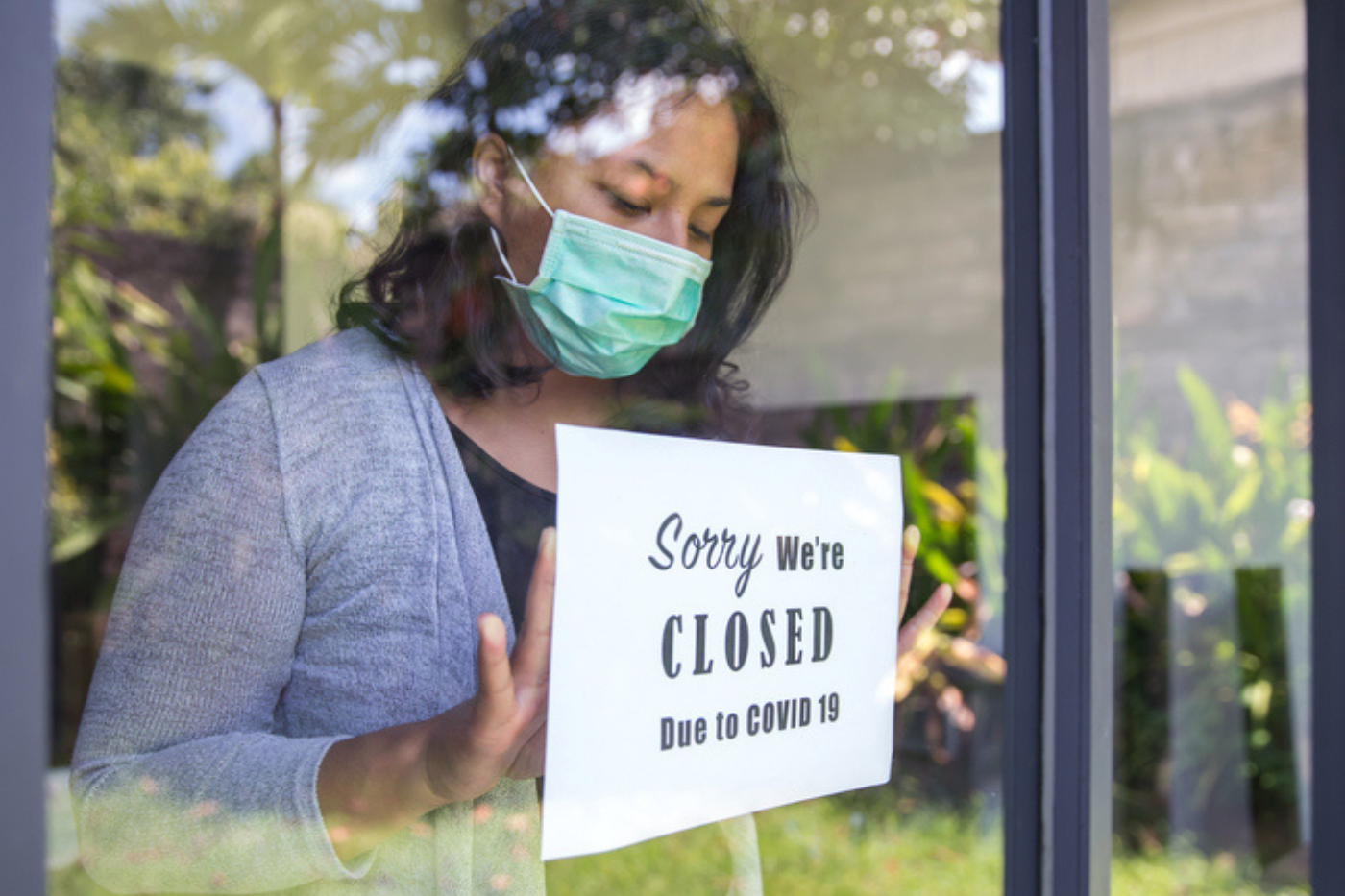
Pandemic Impacts on Self-Employed Latinas in California
Acknowledgments
This data brief series was made possible, in part, with the generous support of the Wells Fargo Foundation and the James Irvine Foundation. Core support for the UCLA Latino Policy and Politics Institute is provided by the California State Legislature and the California Latino Legislative Caucus’ Unseen Latinas Initiative. The research team acknowledges its longstanding partnership with the UCLA Center for Neighborhood Knowledge. The research team is also grateful for the data insights of Misael Galdamez, Allie Padgett, and Chhandara Pech; background research support from Paula Nazario; and review from Professor Kenya Covington.
Introduction
This data brief on California is the first in a series to investigate the impacts of the coronavirus pandemic on Latina entrepreneurship in key states. These data briefs are part of a larger research agenda focused on better understanding not only the impact of the pandemic on diverse forms of Latino entrepreneurship but also thinking forward about the resources communities of color will need as they grapple with the transition to a low-carbon economy. While there are many ways to define entrepreneurship, self-employment is an entry point to other forms of entrepreneurship as well as a strategy for economic survival among disadvantaged Latinas. Self-employment is also an alternative to under-employment or unemployment for Latina women.
This brief uses data from the US Census Bureau’s Household Pulse Survey (HPS) for different time periods between 2020-2022. It is important to note that these data underestimate people who are entrepreneurs because these data display individuals who select self-employment as their primary or only source of income. Therefore, these data do not include those who have another part- or full-time job and use self-employment as supplemental income.
As we emerge from a pandemic that has devastated our community, we need forward-thinking economic recovery plans and policies to ensure Latinas are not left behind in future crises. We must also pivot from a deficit-framing of Latina self-employment and elevate self-employment as an asset to Latino entrepreneurship.
Findings
1. Self-employed Latinas are concentrated in industries that are essential to the stability and security of the United States during the pandemic and were hardest hit at the pandemic onset. Figure 1 shows national data from the 2019 5-year American Community Survey for Self-Employed Latinas by industry. Latina women overwhelmingly populate the Administrative Support and Waste Management Services, Health Care and Social Assistance, and Retail Trade sectors. These sectors are imperative to keep the United States moving forward and surviving through the pandemic. Without individuals working at grocery stores, pharmacies, trash collection, healthcare, and social assistance programs, many households would not have adequate food, water, sanitation, or medicine.
Figure 1: National Distribution of Self-Employed Latinas by Industry (2015-2019)
Source: U.S. Census Bureau, “American Community Survey 2015-2019 5-Year Data Release.
2. During the early part of the pandemic, half (50%) of self-employed Latina women in California lived in or supported lower-income households. Recent surveys highlight that self-employed Latinas are disproportionately concentrated in lower-income households. For instance, by observing the tallest bar in the chart, the figure shows that 51% of self-employed Latinas were supporting or living in lower-income households during the pandemic. These are households making less than $50,000 per year. The opposite is true for self-employed White women where almost 40% live in households with incomes over $100,000 per year.
Figure 2: Distribution of Household Income for Self-Employed Latina and White Women in California
Source: U.S. Census Household Pulse Survey, self-employed population 18 years and older; April 2020 to Dec 2021.
3. Self-employed Latina women faced incredible financial stress during the first 12 months of the coronavirus pandemic. During the first 12 months of the coronavirus pandemic, the HPS asked survey respondents if they, or anyone else in their household, had experienced a loss of employment income. Self-employed Latina women ranked higher than White men, White women, and Latino men in the percentage of households who experienced a loss of employment income at the start of the pandemic. Approximately 76% of self-employed Latinas lived in or supported households that experienced a loss of income during the first 12 months of the coronavirus pandemic.
Figure 3: Loss of Employment Income During First 12 Months of COVID-19 in California
Source: U.S Census Household Pulse Survey; self-employed population 18+; April 2020 to March 2021 (weeks 1 to 27). These estimates are based on a sample that includes respondents who did not report their income.
Question: “Have you, or has anyone in your household experienced a loss of employment income since March 13, 2020?”
4. Self-employed Latina women disproportionately faced financial difficulties while paying household expenses compared to White men and White women, though Latino men suffered similarly in the aftermath of the pandemic. The HPS asked its respondents to rate the difficulty for their household to pay its usual household expenses, including food, rent or mortgage, car payments, medical expenses, and student loans in the last seven days. Between August 2020 and January 2022, Figure 4 shows self-employed Latinas continued to face more financial hardships compared to White women. Latina women have a loss of over 18 percentage points more than White women and over 21 percentage points compared to White men. Specifically, 42% of Latina women reported difficulty in paying their household expenses, including food, housing, car payments, and medical expenses.
Figure 4: Percent Self-Employed in Households Experiencing Difficulty Paying Household Expenses in California
Source: U.S. Census Household Pulse Survey, self-employed population 18+; Aug 2020 to Jan 2022 (weeks 13 to 41).
Question: “In the last 7 days, how difficult has it been for your household to pay for usual household expenses, including but not limited to food, rent or mortgage, car payments, medical expenses, student loans, and so on?” * somewhat or very difficult.
5. Latino men and Latina women are much more likely to be behind on their rent/mortgage payments compared to their White counterparts in the aftermath of the pandemic. When asked if their households are caught up on rent or mortgage payments, 12% of self-employed Latina women responded “no.” Trailing closing behind them, 10% of self-employed Latino men had the same response. Between August 2020 and January 2022, Figure 5 displays striking differences between the self-employed Latino community and the self-employed White community. Latina women have been unable to pay their rent or mortgage 8 percentage points more than both White women and White men.
Figure 5: Percentage of Self-Employed in Households Behind on Rent/Mortgage in California
Source: U.S. Census Household Pulse Survey, self-employed population 18+; Aug 2020 to Jan 2022 (weeks 13 to 41).
Question: “Is this household currently caught up on rent payments?” or “Is this household currently caught up on mortgage payments?” *no
6. Self-employed Latina women continue to face financial stress and vulnerability during the periods of economic recovery in the aftermath of the pandemic. Through analyzing more recent data (after the first 12 months of the pandemic), close to 40% of self-employed Latinas continue to live in or support a household that has experienced a loss of income. In other words, even if it is not at the same levels as the onset of the pandemic, self-employed Latinas are continuing to experience a loss of income. Latina women have lost over 15 percentage points more than White women in employment income and over 24 percentage points more than White men and these losses remained after the first 12 months of the pandemic.
Figure 6: Percent Self-Employed in Households Experiencing Loss of Employment Income (12 Months+ of COVID-19/Recovery)
Source: U.S. Census Household Pulse Survey, self-employed population 18+; April 2021 to Dec 2021( weeks 28 to 41).;
Question: “Have you, or has anyone in your household experienced a loss of employment income in the last 4 weeks?”
Conclusion
Self-employment is a strategy for economic survival and economic growth in Latino communities, an entry point to other forms of entrepreneurship, and an alternative to under-employment or unemployment for Latina women. We show self-employed Latinas were hit harder by the pandemic compared to white women because they were concentrated in industries hardest hit by the pandemic, lived in or supported lower-income households, experienced a disproportionate burden of financial difficulties, and are continuing to experience a slow recovery.
As we emerge from a pandemic that has devastated our community, we need forward-thinking economic recovery plans and policies. Clearly, pandemic economic relief efforts, such as the CARES Act’s Payment Protection Program (PPP), did not reach Latina and Latino entrepreneurs in California as well as they should have. As we continue to plan for a more sustainable economy, we must ensure that Latinas are not left behind. Any future policies must consider the vulnerabilities of small businesses and self-employed individuals, especially those who are more financially disadvantaged. Lastly, we must pivot from the deficit-framing of Latina self-employment to think about Latinas as an asset to entrepreneurship within our community.











